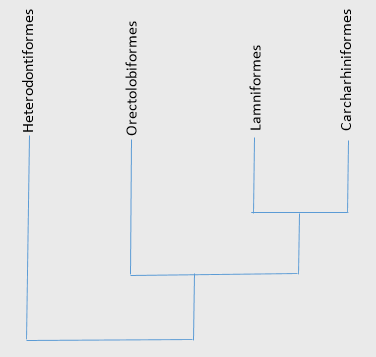
Classification
Classifying an organize follows a system in which organisms are placed into tiers, with each descending group being more specific to that organism.
Domain: Eukaryota
Kingdom: Animalia
Phylum: Chordata
Class: Elasmobranchii
Order: Carcharhiniformes
Family: Carcharhinidae
Genus: Carcharhinus
Species: Carcharhinus melanopterus
Meaning of Carcharhinus melanopterus.
Carcharhinus – animal with sharp nose
-derived from the Greek "karcharos" =
sharp and "rhinos" = nose (Ichthyology 2013).
melano- – black
-pterous – wings
Domain: Eukaryota
Eukaryotic organisms have cells that contain a true nucleus. This includes animals, plants, as well as fungi. Many of the organisms included in this group are multi-cellular, but there are some that are unicellular (Campbell et al 2008). Carcharhinus melanopterus is just one of the many organisms that are included in this domain.
Kingdom: Animalia
Animalia contain organisms that are heterotrophic, multi-cellular, lack a cell wall, reproduce sexually, and are mobile at some point in their life (Campbell et al 2008). Members of this group include The Army Ant (Eciton burchellii), the Rhesus Monkey (Macaca mulatta), and The Grizzly Bear (Ursus arctos) are just a few examples of the vast variety of organisms that make up the Kingdom Animalia.
Phylum: Chordata
Members of the phylum Chordata possess some unique characteristics that separate them from the other phylum. These include a notochord, and a nerve cord. A sub-phylum of this group is Vertebrates (Campbell et al 2008). Vertebrates possess a backbone, and contain organisms ranging from a African Forest Elephant (Loxodonta cyclotis) to a Ganges River Dolphin (Platanista gangetica).
Class: Elasmobranchii
This class, Elasmobranchii, contains sharks, skates, and rays. The key features that these organisms share are a skeleton made up of cartilage, rows of replaceable teeth, and the ability to feel small changes in electricity around them. They use this ability to detect changes in electricity to both find their way through the water as well as detect near by prey. Due to these characteristics, many of the organisms in this class are very skilled hunters, and in many cases, at the top of their food chain (EOL 2013).
Order: Carcharhiniformes
Carcharhiniformes, or ground sharks, is the most abundant of the shark groups with about two-hundred known species. These species range from catsharks to hammerhead sharks usually dwelling in tropical areas. Ground sharks share common characteristics such as an anal fin, dorsal fins, and a nictitating membrane over the eye (BBC 2013).
Family: Carcharhinidae
Members of Carcharhinidae lack spiracles (which is a respiratory opening found in many cartilaginous fish), very sharp blade like teeth, have a second dorsal fin that is smaller than the first, and a well developed nictitating membrane (EOL 2013).
Genus: Carcharhinus
Members of the Carcharhinus include the Blacknose Shark, Copper Shark, and Whitetip Reef Shark (EOL 2013).
Species: Carcharhinus melanopterus
Carcharhinus melanopterus, better known as the Blacktip Reef Shark,
is viviparous, meaning they produce live young, whereas many other
sharks are oviparous meaning they lay eggs to be hatched outside the
mother (Ichthyology
2013). Blacktip Reef Sharks are distinctively characterized by
their black markings located on their fins. The markings are most
dominant on the dorsal fin, and caudal fin, but are still visible on
the pectoral, anal, pelvic, and secondary dorsal fin.

In the phylogenetic tree above synapamorphies are shown seperating the different phylum of the Animalia kingdom. The sister taxon of Chordata is Echinodermata which include organisms such as the starfish, and sea urchins (Campbell et al 2008).

The phylogenetic tree above illustrates the different orders of the class Elasmobranchii, and their relationship to one another. As you can see, the sister taxon of Carcharhiniformes is Lamniformes commonly known as mackerel sharks. This order includes sharks such as the the great white shark, and goblin shark (EOL 2013).